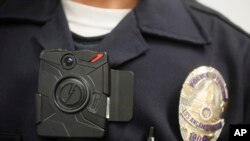The “he said, she said” controversy over the shooting of Michael Brown tearing the city of Ferguson, Missouri, apart is sparking a wave of interest in a technology that has yet to be used widely in the United States.
Body cameras mounted on a police officer’s torso or glasses have been getting a lot of attention in the wake of Ferguson, and rightly so.
In a definitive report prepared for the U.S. Department of Justice (DOJ) earlier this year, body cameras were shown to reduce the incidents of the police using force by 60 percent in the city of Rialto, California. Complaints against police officers there also plummeted 88 percent.
“Given what has been going on in Ferguson, it has become clear that police departments would benefit tremendously by having that equipment because of the evidence,” said Michael White, a professor at Arizona State University’s School of Criminology and Criminal Justice, and the author of the DOJ report.
“You’re hearing two very different stories about what happened,” he said. “We simply don’t know which version is accurate, and as a result, everyone is left to speculate.”
White said that a body camera could have gathered conclusive evidence in the Brown shooting.
Taser, a leading manufacturer of body cameras, began experimenting with cameras in 2006, according to Steve Tuttle, a spokesman for the company.
“What we found was they were tremendous at taking the ‘he said, she said’ element out of incidents,” he said.
Taser makes both a body-mounted camera as well as one that can be mounted on sunglasses.
The Taser cameras are always recording, but the video footage is regularly overwritten, since the cameras have limited storage capacity. In order for it to record and save an incident, the officers must press a button. At that time the camera stores video data from the prior 30 seconds and then begins to record both video and audio of the event.
Tuttle said every frame of saved video is fingerprinted and cannot be altered or changed. The video can be redacted, but it would show as having been redacted.
Despite what appears to be huge advantages to using the cameras, less than a quarter of U.S. police departments are using them, according to White.
“As recently as three years ago, virtually no one was talking about this technology,” he said, adding that while there are 18,000 state and local law enforcement agencies, the two main suppliers of the cameras say their cameras are being used in just over 4,000 agencies combined.
White said that in the U.K., body cameras have been used since 2005.
He said he expects a rapid surge in U.S. police departments using cameras as a result of the Ferguson shooting. He expects the pattern will follow the uptake of Tasers and dashboard-mounted cameras, which faced initial resistance, but are now widely used.
The momentum was already building before Ferguson.
Last August, when Judge Shira Scheindlin ruled that the New York Police Department’s stop-and-frisk program was unconstitutional, she ordered the department to invest in body cameras because it would "alleviate some of the mistrust that has developed between the police and the black and Hispanic communities" and be "helpful to members of the NYPD who are wrongly accused of inappropriate behavior."
Rialto Chief of Police William A. Farrar agreed and was quoted in White’s report.
“When you put a camera on a police officer, they tend to behave a little better, follow the rules a little better,” he said. “And if a citizen knows the officer is wearing a camera, chances are the citizen will behave a little better.”
Still White urges caution, saying police departments can “get into a lot of trouble without the leadership thinking about the issues raised.”
“Buying the hardware is the easy part,” he said.
He also said the “research is mixed” on the “civilizing effect.”
Other concerns raised in White’s report include privacy for both citizens and police officers. And while the price of the cameras has dropped dramatically in the past several years -- a camera can cost as little as $350 -- police departments would have to spend a lot of money on training and policy development.
Some of the costs could be offset by guilty pleas due to video evidence and police departments not having to investigate frivolous complaints against officers. They are required to investigate all complaints, White said, but with irrefutable video evidence, people who manufacture complaints may be dissuaded from doing so.
And privacy concerns may already be lessening.
The American Civil Liberties Union, an individual rights watchdog, called the cameras a “win for all,” if properly implemented.
Police departments seem to be heeding White’s advice to take implementation slowly and deliberately.
“There are many benefits for the community and for the department in the use of [body cameras],” said a spokesman for the Las Vegas Metropolitan Police Department, which is currently studying the effectiveness of body cameras.
“However, as with any new technology, careful thought must be given to all aspects of its procurement and use," he said. "Issues with policy, procedures, legal aspects, cost, management and sustainment are but a few of the considerations the department must examine as it moves forward with the program.”









